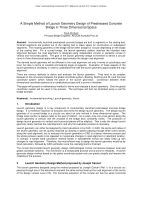Bridges

- Publication no: ABC2017-161-17
- Published: 26 April 2017
- PDF (free) Download
Incrementally launched prestressed concrete bridges are built in segments in the casting bed. Finished segments are pushed out of the casting bed to leave space for construction of subsequent segments. The resulting geometry of the bridge will be either straight or circular depending on the shape of the casting bed. For a curved bridge, the launch geometry seldom matches the intended road alignment because the road alignment is designed using independent circular or parabolic curves in vertical and horizontal planes. The goal of the launch geometry design is therefore to derive a circular curve in three dimensional space which best approximates the design road alignment.
The derived launch geometry will be different to the road alignment not only in terms of coordinates and level, but also in terms of crossfall and bearing angle at supports. Evaluation of these aspects of the launch geometry is necessary in order to understand how well the launch geometry approximates the road alignment.
There are various methods to derive and evaluate the launch geometry. They tend to be complex because of the conversion between the global coordinate system (Easting, Northing and RL) and the local coordinate system (which follows the plane of the launch geometry). Conversion between three dimensional coordinate systems is a complicated process and is prone to mistakes.
This paper will present a mathematical method to derive and evaluate a launch geometry. Only the global coordinate system will be used in the process. The technique will then be illustrated using a real life bridge example.
